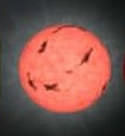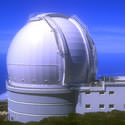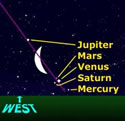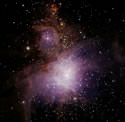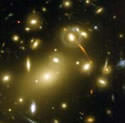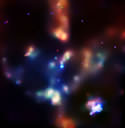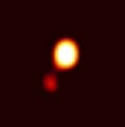
Image credit: Gemini
Thanks to the adaptive optics system of the Gemini observatory, astronomers have been able to spot a brown dwarf orbiting a star only three times the distance of the Earth to the Sun. This newly discovered pair, LHS 2397a, is located only 46 light years from Earth and is the closest separation of a binary star ever uncovered. The Hawaii-based Gemini telescope is so powerful because it uses a flexible mirror that counteracts the blurring caused by the Earth’s atmosphere.
Astronomers using adaptive optics technology on the Gemini North Telescope have observed a brown dwarf orbiting a low-mass star at a distance comparable to just three times the distance between the Earth and Sun. This is the closest separation distance ever found for this type of binary system using direct imaging.
The record-breaking find is just one of a dozen lightweight binary systems observed in the study. Together, they provide a new perspective on the formation of stellar systems and how smaller bodies in the Universe (including large planets) might form.
“By using Gemini’s advanced imaging capabilities, we were able to clearly resolve this binary pair where the distance between the brown dwarf and its parent star is only about twice the distance of Mars from the Sun,” said team member Melanie Freed, a graduate student at the University of Arizona in Tucson. With an estimated mass of 38-70 times the mass of Jupiter, the newly identified brown dwarf is located just three times the Sun-Earth distance (or 3.0 Astronomical Units) from its parent star. The star, known as LHS 2397a, is only 46 light-years from Earth. The motion of this object in the sky indicates that it is an old, very low-mass star.
The previous imaging record for the closest distance between a brown dwarf and its parent (a much brighter, Sun-like star) was almost five times greater at 14 AU. One Astronomical Unit (AU) equals the average distance between the Earth and the Sun or about 150 million kilometers (93 million miles).
Often portrayed as “failed stars,” brown dwarfs are bigger than giant planets like Jupiter, but their individual masses are less than 8% of the Sun’s mass (75 Jupiter masses), so they are not massive enough to shine like a star. Brown dwarfs are best viewed in the infrared because surface heat is released as they slowly contract. The detection of brown dwarf companions within 3 AU of another star is an important step toward imaging massive planets around other stars.
This University of Arizona team led by Dr. Laird Close used the Gemini North Telescope to detect eleven other low mass companions, suggesting that these low-mass binary pairs may be quite common. The discovery of so many low-mass pairs was a surprise, given the argument that most very low-mass stars and brown dwarfs were thought to be solo objects wandering though space alone after being ejected out of their stellar nurseries during the star formation process.
“We have completed the first adaptive optics-based survey of stars with about 1/10th of the Sun’s mass, and we found nature does not discriminate against low-mass stars when it comes to making tight binary pairs,” said Close, an assistant professor of astronomy at the University of Arizona. Dr. Close is the lead author on a paper presented today at the Brown Dwarfs International Astronomical Union Symposium in Kona, Hawaii, and he is the principal investigator of the low-mass star survey.
The team looked at 64 low-mass stars (originally identified by John Gizis of the University of Delaware) that appeared to be solo stars in the lower resolution images from the 2MASS all-sky infrared survey. Once the team used adaptive optics on Gemini to make images that were ten times sharper, twelve of these stars were revealed to have close companions. Surprisingly, Close’s team found that the separation distances between the low mass stars and their companions were significantly less than expected.
“We find companions to low-mass stars are typically only 4 AU from their primary stars, this is surprisingly close together,” said team member Nick Siegler, a University of Arizona graduate student. “More massive binaries have typical separations closer to 30 AU, and many binaries are much wider than this.” The new Gemini observations, Close said, “imply strongly that low-mass stars do not have companions that are far from their primaries.” Similar results had been found previously by a team led by Dr. Eduardo L. Martin of the University of Hawaii Institute for Astronomy in a survey of 34 very low-mass stars and brown dwarfs in the Pleiades cluster carried out with the Hubble Space Telescope. These two surveys together clearly demonstrate that there is an intriguing dearth of brown dwarfs at separations larger than 20 AU from very low-mass stars and other brown dwarfs.
The team projects that one out of every five low-mass stars has a companion with a separation in the range (3-200 AU). Within this separation range, astronomers have observed a similar frequency of more massive stellar companions around larger Sun-like stars.
Taken as a whole, these new results suggest that (contrary to theory) low-mass binaries may form in a process similar to that of more massive binaries. Indeed, this finding adds to growing evidence from other groups that the percentage of binary systems is similar for bodies spanning the range from one solar mass to as little as 0.05 solar masses (or 52 times Jupiter’s mass). For example, a group led by Neill Reid of the Space Telescope Science Institute and the University of Pennsylvania has come to a similar conclusion with a smaller sample of 20 even lower-mass stars and brown dwarfs observed with the Hubble Space Telescope.
The fact that low-mass stars have any low-mass brown dwarf companions inside 5 AU is also surprising because the exact opposite is true around Sun-like stars. Very few Sun-like stars have brown dwarf companions inside this distance, according to radial velocity studies. “This lack of brown dwarf companions within 5 AU of Sun-like stars has been called the ‘brown dwarf desert’,” Close noted. “However, we see there is likely no brown dwarf desert around low-mass stars.”
These results form important constraints for theorists working to understand how the mass of a star affects the mass and separation distance of the companions that form with it. “Any accurate model of star and planet formation must reproduce these observations,” Close said.
These observations were possible only because of the combination of the University of Hawaii’s uniquely sensitive Hokupa’a adaptive optics imaging system and the technical performance of the Gemini telescopes. The Hokupa’a system sensitivity is due to the curvature wavefront sensing concept developed by Dr. Francois Roddier. Adaptive optics is an increasingly crucial technology that eliminates most of the “blurring” caused by the turbulence in the Earth’s atmosphere (i.e., the twinkling of the stars). It does this by rapidly adjusting the shape of a special, smaller flexible mirror to match local turbulence, based on real-time feedback to the mirror’s support system from observations of the low-mass star. Hokupa’a can count individual photons (particles of light) and so can sharpen accurately even very faint (i.e., low-mass) stars.
The near-infrared adaptive optics images made by the 8-meter Gemini telescope in this survey were twice as sharp as those that can be made at the same wavelengths by the Earth-orbiting, 2.4-meter Hubble Space Telescope. The only ground-based survey of its kind, this work required five nights over one year with the Hokupa’a system at Gemini North.
It is important to note that the distances used here are as measured on the sky. The real orbital separations may be slightly larger once the full orbit of these binaries is known in the future.
Other science team members include James Liebert (Steward Observatory, University of Arizona), Wolfgang Brandner (European Southern Observatory, Garching, Germany), and Eduardo Martin and Dan Potter (Institute for Astronomy, University of Hawaii).
The observations reported here are part of an ongoing survey. Initial results from the first 20 low-mass stars of our survey have been published in the March 1, 2002 issue of The Astrophysical Journal Letters vol 567 Pages L53-L57.
Images and illustrations related to this news release are available on the Internet at: http://www.gemini.edu/media/images_2002-7.html.
Laird Close can be contacted at 520/626-5992, [email protected], after he returns to his office on May 28.
This survey was supported in part by the U.S. Air Force Office of Scientific Research and the University of Arizona’s Steward Observatory. Hokupa’a is supported by the University of Hawaii Adaptive Optics Group and the National Science Foundation.
The Gemini Observatory is an international collaboration that has built two identical 8-meter telescopes. The telescopes are located at Mauna Kea, Hawaii (Gemini North) and Cerro Pach?n in central Chile (Gemini South), and hence provide full coverage of both hemispheres of the sky. Both telescopes incorporate new technologies that allow large, relatively thin mirrors under active control to collect and focus both optical and infrared radiation from space.
The Gemini Observatory provides the astronomical communities in each partner country with state-of-the-art astronomical facilities that allocate observing time in proportion to each country’s contribution. In addition to financial support, each country also contributes significant scientific and technical resources. The national research agencies that form the Gemini partnership include: the US National Science Foundation (NSF), the UK Particle Physics and Astronomy Research Council (PPARC), the Canadian National Research Council (NRC), the Chilean Comisi?n Nacional de Investigaci?n Cientifica y Tecnol?gica (CONICYT), the Australian Research Council (ARC), the Argentinean Consejo Nacional de Investigaciones Cient?ficas y T?cnicas (CONICET) and the Brazilian Conselho Nacional de Desenvolvimento Cient?fico e Tecnol?gico (CNPq). The Observatory is managed by the Association of Universities for Research in Astronomy, Inc. (AURA) under a cooperative agreement with the NSF. The NSF also serves as the executive agency for the international partnership.
For more information, see the Gemini website at: http://www.us-gemini.noao.edu/media/.
Original Source: Gemini News Release
